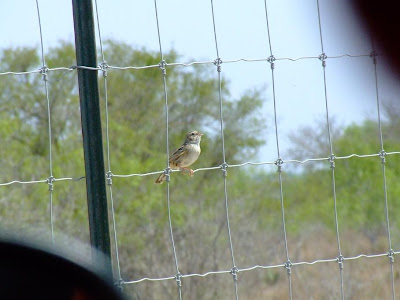
Beep-beep... beep-beep... Why are alarm clocks such horrible things to wake up to in the morning? I pondered this while extricating myself from bed early Friday morning. We had to leave the hotel by five to get to the upriver areas we were scouting today by dawn. Maybe I should have gone to bed earlier - four hours isn't very much.
After a long drive (almost seventy miles) we finally reached Santa Margarita Ranch (pictured above). Much of the ranch is arid brush land, with birds such as Verdin, Black-throated Sparrow, Pyrrhuloxia, and Cactus Wren, but a moist strip of riparian habitat lines the banks of the Rio Grande. As we drove in, Lesser Nighthawks coursed through the air in pursuit of insects.
Number One led us to a bluff overlooking the Rio Grande. The Rio Grande is a highway for many different kinds of birds. Egrets, herons, doves, and ducks were flying up and down the river. I spotted a Red-billed Pigeon perched up on top of a snag downriver - first lifer of the day. This sought-after species's range barely juts up into the United States. A slow, mournful whistle drifting up from the brush below caught our attention, for a good reason: Audubon's Oriole! It eventually popped into view. Another lifer, and my 600th life bird.

Suddenly, two large black birds with white wing patches swung into view around a bend in the river. Muscovy Ducks! This species is well-known throughout the United States, since released/escaped domestic individuals are common in urban parks; only here in southernmost Texas do wild Muscovy Ducks occur.

Our next stop was Salineno. There's a small boat ramp on the river's edge, and some nice riparian vegetation. An interesting incident delayed us here longer than we had anticipated, but we made the most of it and found some interesting birds.

A beautifully-marked Spotted Sandpiper was teetering his (or her?) way along the edge of the boat ramp most of the time we were present. It's nice to see them with spots! I imagine it is a female, since it is so brightly marked.

We also came across this duskywing basking on the ground near the van. After much studying and arguing, we came up with the identification of Funereal Duskywing (Erynnis funeralis).

On our way out of Salineno, we birded the Salineno Dump Road. As the name implies, the road is a dump. Random trash, including toilets, old tires, and beer cans, litters the ground along the road. It's sad to see how the environment is trashed down in southern Texas. And, of course, there's the whole mess with the proposed border wall. We found a second-year male Painted Bunting singing sweetly away right beside the road and several feet above an abandoned toilet. Sorry yet again Chris - just skip over the photo.

We took a spin around Starr County Park, which lies almost in the shadow of the Falcon Dam water tower. Some people would call it a campground; I would call it land with some crude picnic tables, shelters, and restrooms slapped hastily on it.

Starr County Park is covered with grassland and dry, scraggly bushes. This whole upriver area has several species of birds, such as Ash-throated Flycatcher, Black-throated Sparrow, and Vermilion Flycatcher, that are impossible or extremely hard to find farther downriver. It's a long drive for a big day, but it's worth the gamble because of these different species. As we jolted down the rough gravel road through the "campground", Bunting Boy spotted one of these: a brilliant male Vermilion Flycatcher sitting up on a bush. Someone else spotted an Ash-throated Flycatcher perched on some nearby telephone wires. A common enough species in Orange County, yet a "must-have" species on a big day in the Lower Rio Grande Valley.

A few sparrows swirled out of the grass in front of the car. Sparrows of any kind are not very numerous in the Lower Rio Grande Valley at this time of the year, so they were worth a look. The white tail tips flashing as they flitted away instantly identified them as Lark Sparrows. Hop spotted a different sparrow sitting in a nearby bush - a Lark Bunting, a decent bird for this late in the year. Another life bird for me.
We cruised down some nearby roads, looking for Cassin's Sparrows. Eventually, we found one singing right along the road. This dull brown bird gets my vote for the best singer in the United States. Although certainly not impressive to look at, as soon as it opens its bill and pours out its poignant song, you'll be amazed. We even saw it skylarking (floating through the air while pouring out that song). It landed on the fence right outside the car - here it is, as seen between the car's side mirror and Number One's ear.

With that, we pulled a U-turn and sped back towards McAllen. Bedtime: 3:00 p.m. Big day coming. Need sleep.
No comments:
Post a Comment